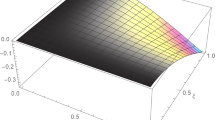Abstract
The computation of lower eigenvalue bounds for the biharmonic operator in the buckling of plates is vital for the safety assessment in structural mechanics and highly on demand for the separation of eigenvalues for the plate’s vibrations. This paper shows that the eigenvalue provided by the nonconforming Morley finite element analysis, which is perhaps a lower eigenvalue bound for the biharmonic eigenvalue in the asymptotic sense, is not always a lower bound. A fully-explicit error analysis of the Morley interpolation operator with all the multiplicative constants enables a computable guaranteed lower eigenvalue bound. This paper provides numerical computations of those lower eigenvalue bounds and studies applications for the vibration and the stability of a biharmonic plate with different lower-order terms.






Similar content being viewed by others
References
Brenner, S.C., Scott, L.R.: The mathematical theory of finite element methods, texts in applied mathematics, vol. 15, 3rd edn. Springer, New York (2008)
Carstensen, C., Gedicke, J.: Guaranteed lower bounds for eigenvalues. Math. Comp. Accepted for publication (2013)
Carstensen, C., Gedicke, J., Rim, D.: Explicit error estimates for Courant, Crouzeix-Raviart and Raviart-Thomas finite element methods. J. Comput. Math. 30(4), 337–353 (2012)
Ciarlet, P.G.: The finite element method for elliptic problems. Studies in Mathematics and its Applications, vol. 4. North-Holland Publishing Co., Amsterdam (1978)
Evans, L.C.: Partial differential equations, Graduate Studies in Mathematics, vol. 19, 2nd edn. American Mathematical Society, Providence (2010)
Laugesen, R.S., Siudeja, B.A.: Minimizing Neumann fundamental tones of triangles: an optimal Poincaré inequality. J. Diff. Equ. 249(1), 118–135 (2010)
Parlett, B.N.: The symmetric eigenvalue problem, Classics in Applied Mathematics, vol. 20. Society for Industrial and Applied Mathematics (SIAM), Philadelphia, PA (1998). Corrected reprint of the 1980 original
Rannacher, R.: Nonconforming finite element methods for eigenvalue problems in linear plate theory. Numer. Math. 33(1), 23–42 (1979)
Timoshenko, S., Gere, J.: Theory of elastic stability. Engineering Societies Monographs. MacGraw-Hill International, New York (1985)
Yang, Y., Lin, Q., Bi, H., Li, Q.: Eigenvalue approximations from below using Morley elements. Adv. Comput. Math. 36, 443–450 (2011)
Author information
Authors and Affiliations
Corresponding author
Additional information
This work was supported by the DFG Research Center MATHEON.
Dedicated to Dietrich Braess on the occasion of his 75th birthday.
Rights and permissions
About this article
Cite this article
Carstensen, C., Gallistl, D. Guaranteed lower eigenvalue bounds for the biharmonic equation. Numer. Math. 126, 33–51 (2014). https://doi.org/10.1007/s00211-013-0559-z
Received:
Revised:
Published:
Issue Date:
DOI: https://doi.org/10.1007/s00211-013-0559-z




